[English] 日本語
 Yorodumi
Yorodumi- PDB-7x35: Cryo-EM structure of Coxsackievirus B1 A-particle in complex with... -
+ Open data
Open data
- Basic information
Basic information
| Entry | Database: PDB / ID: 7x35 | |||||||||||||||||||||
|---|---|---|---|---|---|---|---|---|---|---|---|---|---|---|---|---|---|---|---|---|---|---|
| Title | Cryo-EM structure of Coxsackievirus B1 A-particle in complex with nAb 8A10 (CVB1-A:8A10) | |||||||||||||||||||||
 Components Components |
| |||||||||||||||||||||
 Keywords Keywords | VIRUS / Coxsackievirus B1 / Neutralizing antibody / Cryo-EM | |||||||||||||||||||||
| Function / homology |  Function and homology information Function and homology informationsymbiont-mediated suppression of host cytoplasmic pattern recognition receptor signaling pathway via inhibition of RIG-I activity / picornain 2A / symbiont-mediated suppression of host mRNA export from nucleus / symbiont genome entry into host cell via pore formation in plasma membrane / picornain 3C / T=pseudo3 icosahedral viral capsid / ribonucleoside triphosphate phosphatase activity / host cell cytoplasmic vesicle membrane / viral capsid / nucleoside-triphosphate phosphatase ...symbiont-mediated suppression of host cytoplasmic pattern recognition receptor signaling pathway via inhibition of RIG-I activity / picornain 2A / symbiont-mediated suppression of host mRNA export from nucleus / symbiont genome entry into host cell via pore formation in plasma membrane / picornain 3C / T=pseudo3 icosahedral viral capsid / ribonucleoside triphosphate phosphatase activity / host cell cytoplasmic vesicle membrane / viral capsid / nucleoside-triphosphate phosphatase / host cell / channel activity / monoatomic ion transmembrane transport / DNA replication / RNA helicase activity / endocytosis involved in viral entry into host cell / symbiont-mediated activation of host autophagy / RNA-directed RNA polymerase / cysteine-type endopeptidase activity / viral RNA genome replication / RNA-directed RNA polymerase activity / DNA-templated transcription / symbiont entry into host cell / virion attachment to host cell / host cell nucleus / structural molecule activity / proteolysis / RNA binding / zinc ion binding / ATP binding / membrane Similarity search - Function | |||||||||||||||||||||
| Biological species |  Coxsackievirus B1 Coxsackievirus B1 | |||||||||||||||||||||
| Method | ELECTRON MICROSCOPY / single particle reconstruction / cryo EM / Resolution: 3.19 Å | |||||||||||||||||||||
 Authors Authors | Zheng, Q. / Zhu, R. / Sun, H. / Cheng, T. / Li, S. / Xia, N. | |||||||||||||||||||||
| Funding support | 1items
| |||||||||||||||||||||
 Citation Citation |  Journal: Cell Host Microbe / Year: 2022 Journal: Cell Host Microbe / Year: 2022Title: Structural basis for the synergistic neutralization of coxsackievirus B1 by a triple-antibody cocktail. Authors: Qingbing Zheng / Rui Zhu / Zhichao Yin / Longfa Xu / Hui Sun / Hai Yu / Yuanyuan Wu / Yichao Jiang / Qiongzi Huang / Yang Huang / Dongqing Zhang / Liqin Liu / Hongwei Yang / Maozhou He / ...Authors: Qingbing Zheng / Rui Zhu / Zhichao Yin / Longfa Xu / Hui Sun / Hai Yu / Yuanyuan Wu / Yichao Jiang / Qiongzi Huang / Yang Huang / Dongqing Zhang / Liqin Liu / Hongwei Yang / Maozhou He / Zhenhong Zhou / Yanan Jiang / Zhenqin Chen / Huan Zhao / Yuqiong Que / Zhibo Kong / Lizhi Zhou / Tingting Li / Jun Zhang / Wenxin Luo / Ying Gu / Tong Cheng / Shaowei Li / Ningshao Xia /  Abstract: Coxsackievirus B1 (CVB1) is an emerging pathogen associated with severe neonatal diseases including aseptic meningitis, myocarditis, and pancreatitis and also with the development of type 1 diabetes. ...Coxsackievirus B1 (CVB1) is an emerging pathogen associated with severe neonatal diseases including aseptic meningitis, myocarditis, and pancreatitis and also with the development of type 1 diabetes. We characterize the binding and therapeutic efficacies of three CVB1-specific neutralizing antibodies (nAbs) identified for their ability to inhibit host receptor engagement. High-resolution cryo-EM structures showed that these antibodies recognize different epitopes but with an overlapping region in the capsid VP2 protein and specifically the highly variable EF loop. Moreover, they perturb capsid-receptor interactions by binding various viral particle forms. Antibody combinations achieve synergetic neutralization via a stepwise capsid transition and virion disruption, indicating dynamic changes in the virion in response to multiple nAbs targeting the receptor-binding site. Furthermore, this three-antibody cocktail protects against lethal challenge in neonatal mice and limits pancreatitis and viral replication in a non-obese diabetic mouse model. These results illustrate the utility of nAbs for rational design of therapeutics against picornaviruses such as CVB. | |||||||||||||||||||||
| History |
|
- Structure visualization
Structure visualization
| Structure viewer | Molecule:  Molmil Molmil Jmol/JSmol Jmol/JSmol |
|---|
- Downloads & links
Downloads & links
- Download
Download
| PDBx/mmCIF format |  7x35.cif.gz 7x35.cif.gz | 170.4 KB | Display |  PDBx/mmCIF format PDBx/mmCIF format |
|---|---|---|---|---|
| PDB format |  pdb7x35.ent.gz pdb7x35.ent.gz | 132.8 KB | Display |  PDB format PDB format |
| PDBx/mmJSON format |  7x35.json.gz 7x35.json.gz | Tree view |  PDBx/mmJSON format PDBx/mmJSON format | |
| Others |  Other downloads Other downloads |
-Validation report
| Summary document |  7x35_validation.pdf.gz 7x35_validation.pdf.gz | 994.7 KB | Display |  wwPDB validaton report wwPDB validaton report |
|---|---|---|---|---|
| Full document |  7x35_full_validation.pdf.gz 7x35_full_validation.pdf.gz | 998.8 KB | Display | |
| Data in XML |  7x35_validation.xml.gz 7x35_validation.xml.gz | 31.2 KB | Display | |
| Data in CIF |  7x35_validation.cif.gz 7x35_validation.cif.gz | 46.5 KB | Display | |
| Arichive directory |  https://data.pdbj.org/pub/pdb/validation_reports/x3/7x35 https://data.pdbj.org/pub/pdb/validation_reports/x3/7x35 ftp://data.pdbj.org/pub/pdb/validation_reports/x3/7x35 ftp://data.pdbj.org/pub/pdb/validation_reports/x3/7x35 | HTTPS FTP |
-Related structure data
| Related structure data |  32979MC 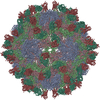 7x2gC 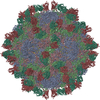 7x2iC 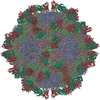 7x2oC 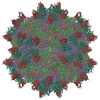 7x2tC 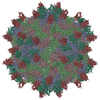 7x2wC 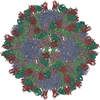 7x37C 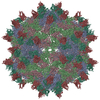 7x38C 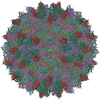 7x3cC 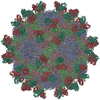 7x3dC  7x3eC 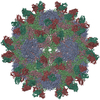 7x3fC 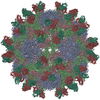 7x3yC  7x40C 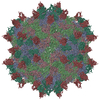 7x42C 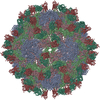 7x46C 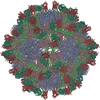 7x47C 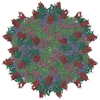 7x49C 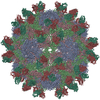 7x4kC 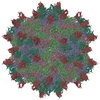 7x4mC M: map data used to model this data C: citing same article ( |
|---|---|
| Similar structure data | Similarity search - Function & homology  F&H Search F&H Search |
- Links
Links
- Assembly
Assembly
| Deposited unit | 
|
|---|---|
| 1 | x 60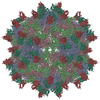
|
| 2 |
|
| 3 | x 5
|
| 4 | x 6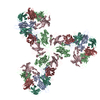
|
| 5 | 
|
| Symmetry | Point symmetry: (Schoenflies symbol: I (icosahedral)) |
- Components
Components
| #1: Protein | Mass: 31207.117 Da / Num. of mol.: 1 / Source method: isolated from a natural source / Source: (natural)  Coxsackievirus B1 / References: UniProt: W8GTF7 Coxsackievirus B1 / References: UniProt: W8GTF7 |
|---|---|
| #2: Protein | Mass: 29122.744 Da / Num. of mol.: 1 / Source method: isolated from a natural source / Source: (natural)  Coxsackievirus B1 / References: UniProt: A0A2S0RQC2 Coxsackievirus B1 / References: UniProt: A0A2S0RQC2 |
| #3: Protein | Mass: 26328.764 Da / Num. of mol.: 1 / Source method: isolated from a natural source / Source: (natural)  Coxsackievirus B1 Coxsackievirus B1References: UniProt: L7UV52, picornain 2A, nucleoside-triphosphate phosphatase, picornain 3C, RNA-directed RNA polymerase |
| #4: Antibody | Mass: 13323.863 Da / Num. of mol.: 1 / Source method: isolated from a natural source / Source: (natural)  |
| #5: Antibody | Mass: 11945.163 Da / Num. of mol.: 1 / Source method: isolated from a natural source / Source: (natural)  |
| Has protein modification | Y |
-Experimental details
-Experiment
| Experiment | Method: ELECTRON MICROSCOPY |
|---|---|
| EM experiment | Aggregation state: PARTICLE / 3D reconstruction method: single particle reconstruction |
- Sample preparation
Sample preparation
| Component | Name: Coxsackievirus B1 / Type: VIRUS / Entity ID: #5, #4, #1-#3 / Source: NATURAL |
|---|---|
| Source (natural) | Organism:  Coxsackievirus B1 Coxsackievirus B1 |
| Details of virus | Empty: NO / Enveloped: YES / Isolate: STRAIN / Type: VIRION |
| Buffer solution | pH: 7.4 |
| Specimen | Embedding applied: NO / Shadowing applied: NO / Staining applied: NO / Vitrification applied: YES |
| Vitrification | Cryogen name: ETHANE |
- Electron microscopy imaging
Electron microscopy imaging
| Experimental equipment |  Model: Tecnai F30 / Image courtesy: FEI Company |
|---|---|
| Microscopy | Model: FEI TECNAI F30 |
| Electron gun | Electron source:  FIELD EMISSION GUN / Accelerating voltage: 300 kV / Illumination mode: FLOOD BEAM FIELD EMISSION GUN / Accelerating voltage: 300 kV / Illumination mode: FLOOD BEAM |
| Electron lens | Mode: BRIGHT FIELD / Nominal defocus max: 3300 nm / Nominal defocus min: 1200 nm |
| Image recording | Electron dose: 60 e/Å2 / Detector mode: COUNTING / Film or detector model: FEI FALCON III (4k x 4k) |
- Processing
Processing
| Software | Name: PHENIX / Version: 1.14_3259: / Classification: refinement |
|---|---|
| EM software | Name: PHENIX / Category: model refinement |
| CTF correction | Type: PHASE FLIPPING AND AMPLITUDE CORRECTION |
| 3D reconstruction | Resolution: 3.19 Å / Resolution method: FSC 0.143 CUT-OFF / Num. of particles: 53960 / Symmetry type: POINT |
 Movie
Movie Controller
Controller























 PDBj
PDBj




